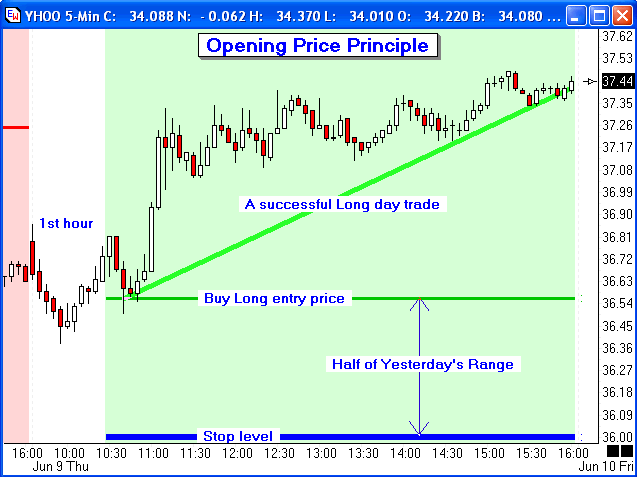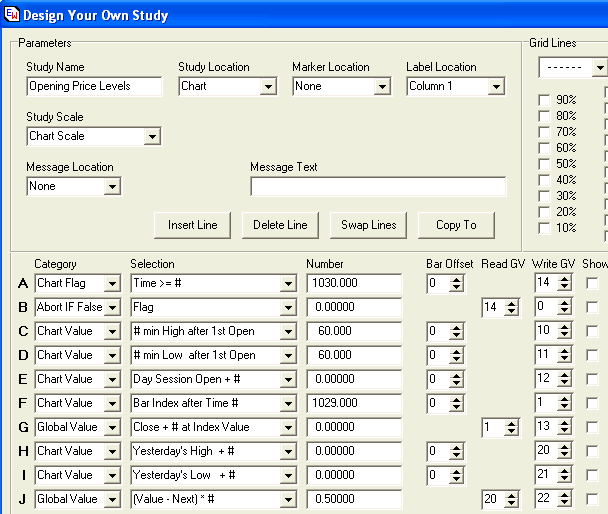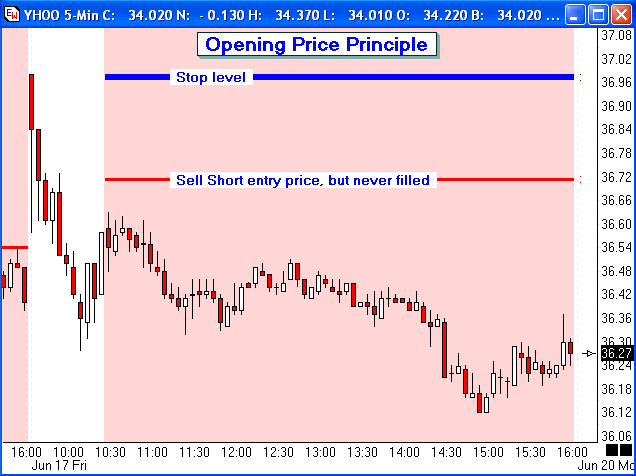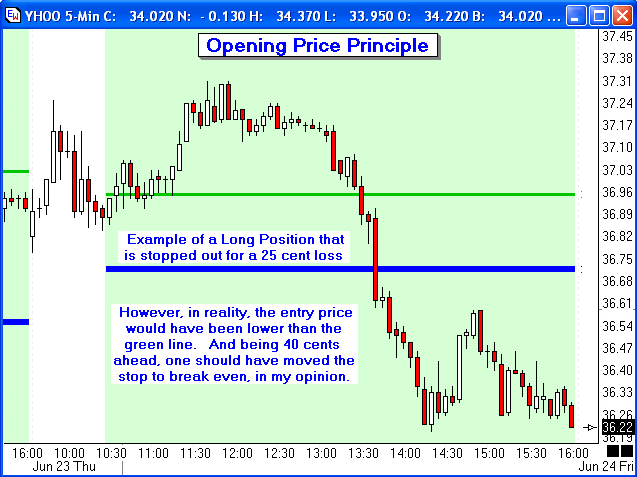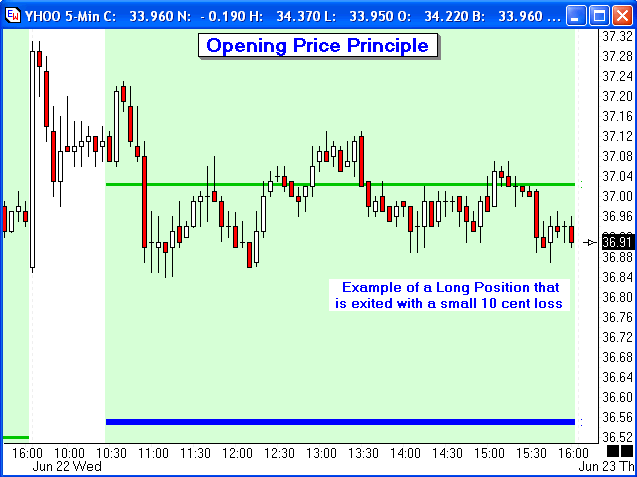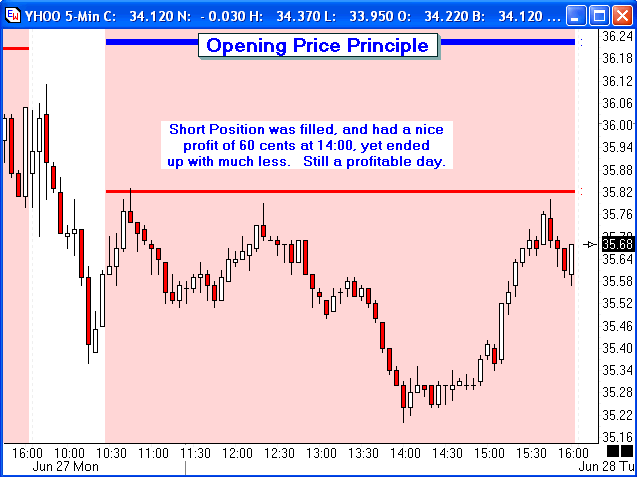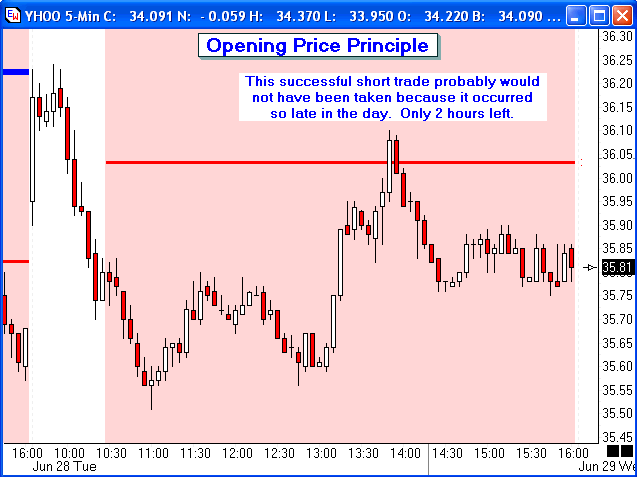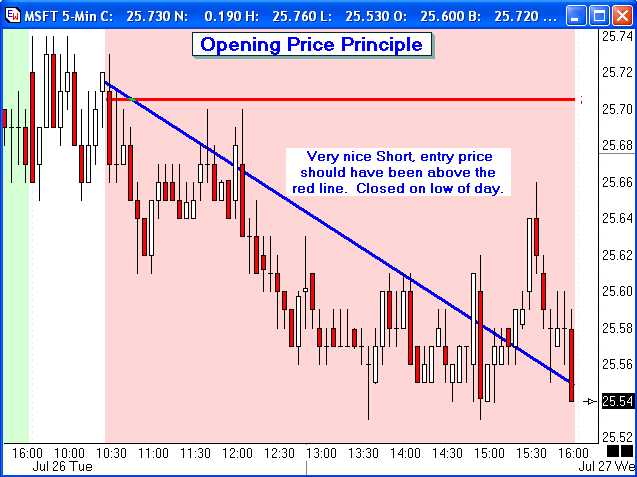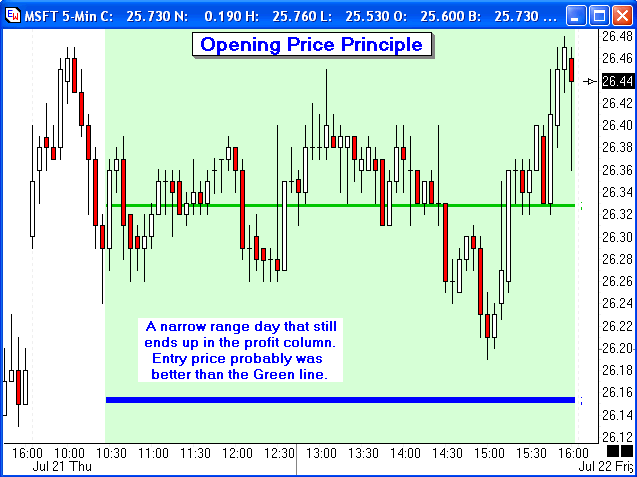Larry Pesavento's Method by Howard Arrington At Ensign's highly successful training seminar in Salt Lake City, Larry Pesavento taught his 'Opening Price Principle', which can be summarized with the following rules. This trading method can to be used with active NASDAQ and NYSE stocks trading above $20.
The Opening Price Principle is based on a statistic that the opening price is within 25% of the high or low of the daily range 65% of the time. Therefore, use this statistic to your advantage by trading in the direction of the market in relation to the opening price. When the market is trading below the open, a short position will be taken. When the market is trading above the open, a long position will be taken. Additional examples of this principle will be illustrated. But before getting there, the Opening Price Principle can be automated using the Design Your Own™ study in Ensign Windows. Three DYO set-ups will be shown, and then used to evaluate the Opening Price Principle on several charts.
Line A compares the bar's time with 10:30. The charts shown use Eastern Time, so 10:30 is one hour after the 9:30 open time. Edit the numbers on Line A and on Line F to reflect the time zone used by your charts. The Boolean result of the test on Line A is stored in GV [14] for later use, such as by Line B. Line B tests the Boolean result from Line A. If the time is during the 1st hour of trading, the evaluation is aborted. The balance of the DYO is evaluated only when the time is after the 1st hour of trading. Line C finds the High in the first 60
minutes of trading and stores this 60-min High in GV [10]. Lines H, I and J find the range for Yesterday and store yesterday's half range value in GV [22]. The values needed to compute the entry price levels and stops have been found and stored in Global Variables for use by the following two DYOs.
Line A tests the 1st hour time condition previously stored in GV [14] and aborts if the time is ahead of 10:30. Line B tests whether the Close in [13] is above the Open in [12] and stores the Boolean result in GV [1]. Line C looks a the Line B result and aborts execution when the Close is below the Open. Line B will also color the background of a Buy day with the light green color. Uncheck the Show box on Line B to remove this background coloring. Line D calculates the Buy Long entry price. Value is the High in [10] and Next is the Low in [11]. 0.618 of this range is subtracted from the High. The Buy Long entry price is stored in GV [23] and plotted on the chart as a thick Green line. The entry price and the word 'Buy' will show in the right side margin for the current day. Line E calculates the Stop price by subtracting half of yesterday's range stored in [22] from the entry price in [23]. The stop level is plotted on the chart as a fat blue bar, which will be below the Buy Long entry price line. The Stop line is also labeled in the right side margin with its price and the word 'Stop'.
The 3rd DYO is a mirror image of the previous DYO. It tests for the Close price in [13] being below the Open price in [12], and computes the Sell Short entry price and the protective Stop price. The Sell Short entry price is shown on the chart using a thick Red line and labeled with its price and the word 'Sell' in the margin. The Stop line is shown in Blue. A template for the Opening Price Principle containing these three DYOs can be downloaded from the Ensign web site using the Internet Services form. The name of the template is OpeningPrice. Obviously, the initial example was hand picked to be an excellent example of the Opening Price Principle. It does not happen so perfectly every day. Often the market does not retrace to the entry price level and your Limit Order is never filled, as in the following example chart.
There will be days when the protective stop is touched and the trade is stopped out with a loss, as shown in the next example. One should consider moving the Stop to break-even after a sufficient profit has been achieved.
On other days, the exit at the end of the day will be with either a small gain or a small loss, as illustrated in the next chart.
The Opening Price Principle has merit and is worth your consideration and further investigation. Consider the following charts illustrating when the Opening Price Principle resulted in a successful day-trade.
As a quick and simple investigation, I picked 10 stock symbols without any foreknowledge of how they have performed during the month of July and summarized the results of the Opening Price Principle in the following table. 'NT' will mean 'No Trade'. Though the direction was correct for the day, the market did not have a retracement sufficient to get a fill on the limit order. Thus the method missed the ensuing directional move. 'LT' will indicate a 'Late Trade' which probably would not have been taken because too little time remained in the day for a good trade to develop. 'BE' indicates the stop should have been moved to break even, in my opinion, after being sufficiently profitable during the day. The numbers are an estimated win (green) or loss (red) shown in pennies as the spread between the exit price and the entry price. A 'L' indicates a Long Position was taken. A 'S' indicates a Short Position was taken.
Though the method appears to be profitable, the area of the No Trade days is of great interest to me. These are directional days where the direction was correctly called, but the position was not established because the market did not retrace to the entry price. Further research is needed to see if it would be profitable to establish half of one's position immediately using the 10:30 closing price, and the other half of the position at the entry price calculated by the Opening Price Principle. Perhaps this type of research can be published in a future Trading Tips issue. I hope you enjoyed this article about Larry Pesavento's Opening Price Principle as I understand it after having been exposed to it at the Ensign training seminar. See the follow up article on the Opening Price Principle in the August 2005 Trading Tips Newsletter. |
